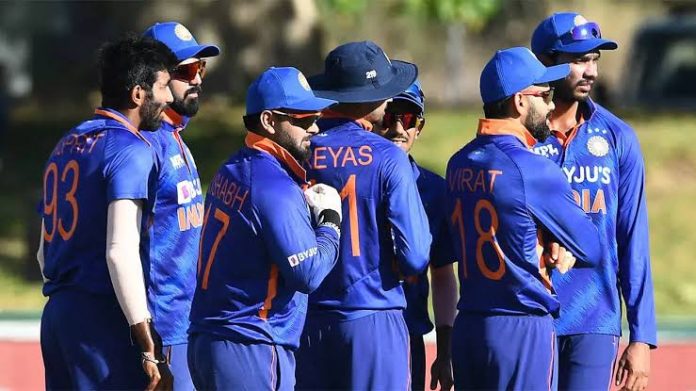India have announced the squad for the Asia Cup to be played in the UAE from August 27 till September 11, by which time they will have to announce the provisional squad for the T20 World Cup in Australia. The 15 picked gives a clear indicator of the players likely to be on the plane to Australia, with some spots still up for grabs. The two big names missing from the squad are Jasprit Bumrah and Harshal Patel, both of whom are certain starters in the XI, but the latter is racing against time to be fit for the mega-event.
India’s squad for the Asia Cup: Rohit Sharma (Captain), KL Rahul (vice-captain), Virat Kohli, Surya Kumar Yadav, Deepak Hooda, Rishabh Pant (wicket-keeper), Dinesh Karthik (wicket-keeper), Hardik Pandya, Ravindra Jadeja, R. Ashwin, Yuzvendra Chahal, Ravi Bishnoi, Bhuvneshwar Kumar, Arshdeep Singh, Avesh Khan
Reserves: Shreyas Iyer, Axar Patel, Deepak Chahar
It can be considered with reasonable conviction that nine players – skipper Rohit Sharma, KL Rahul, Virat Kohli, Surya Kumar Yadav, Hardik Pandya, Ravindra Jadeja, Yuzvendra Chahal, Jasprit Bumrah and Bhuvneshwar Kumar, are lock-ins in the starting XI, with two spots still open. Rahul and Kohli return after missing most of the action post the last World Cup. In this stats feature, we will look at how their respective return impacts the XI. The rest of the squad is likely to be comprised of a backup, each in opening, middle order, spin, and seam department respectively.
Who will open with Rohit Sharma?
Rahul was the incumbent opener in the last World Cup but since then he has featured in only two matches in the format for India, last of which came in November 2021. Rahul has been India’s most prolific opener in the last half a decade, be it T20 Internationals or IPL, and if he is fit should slot right back in at the top of the order. Having once proclaimed ‘strike rates are very, very overrated‘, it remains to be seen how far Rahul buys into India’s new attacking batting philosophy. India have scored at nearly nine an over in the Powerplay post the last World Cup, often willing to risk wickets upfront in pursuit of boundaries – something which is an anathema to Rahul’s preferred style of play.
In Rahul’s absence, India have tried Ishan Kishan, Surya Kumar Yadav, Deepak Hooda, Shreyas Iyer and Sanju Samson as openers while Virat Kohli has also essayed that role in the past. India have toyed with the idea of a southpaw at the top to break the run of right-handers even as recent as the last year’s World Cup. All of India’s top four right-handers have struggled to break free against left-arm finger spin in recent times in T20 cricket, something which Pakistan and New Zealand used effectively against them in the World Cup last year.
How will the middle shape up?
In an ideal world, Kohli should slot in at three given his stature. While his recent numbers in the format are still respectable, Kohli’s struggles in wider T20 cricket – extended to the IPL – has been to find boundaries regularly against spin in the middle overs – a prerequisite for someone batting at three especially when the team is looking to approach this phase aggressively. Kohli has featured in four T20Is in 2022 and has perished playing uncharacteristic shots in the look out for boundaries in three of them while struggles against spin after the field spread out underlined his knock in the fourth. Kohli should start at three in the UAE, and he will have to fight out this apparent weakness against the likes of Rashid Khan, Wanindu Hasaranga and Shadab Khan no less.
At the start of the IPL, the player who was the #1 contender for Kohli’s #3 spot was Shreyas Iyer, but his form has nosedived since the halfway mark of IPL and Iyer’s loss turned out to be Deepak Hooda’s gain. Hooda has made most of the opportunities batting up the order, be it for India or for Lucknow Super Giants, and is equally adept against both pace and spin which gives him the flexibility to slot in anywhere in the top six. With Chahal and Jadeja primed for the two first-choice spinners, Hooda’s part time off-break also offer India a matchup option against left-handers.
While he has been India’s best batter in Tests and ODIs across the last two years, Pant has struggled big time in T20 Internationals and despite the repeated failures, the management has been ready to provide him a longer rope than most others, given his destructive ability to tear apart bowling attacks.
Spin has been Pant’s kryptonite in T20Is, and it is against this backdrop that India would want to employ Pant as a left-handed middle overs spin-hitter. India would ideally want Pant to emulate his IPL 2022 performances in the World Cup, where he did not cross 50 even once but scored at a strike rate of 152 batting in the middle order; the key stat being his strike rate of 189 against leg-spin and left-arm orthodox bowlers. Pant was tried as an opener in T20Is in England and India could use him at the top against opponents that regularly use left-arm spin in the Powerplay, like Pakistan and South Africa, both of whom are pooled with India in Group 2. The fact that he is the only left-hander in the squad who can slot in the top five should push his case for selection.
Rohit said ahead of the third T20I against the West Indies: “We want the guys to be able to bat anywhere and don’t want them to be batting in specific positions. We want the guys to be flexible, there are two ways to look at it depending on certain players.”
India would want their batting order to be flexible going into the World Cup to not only play matchups but also to keep the opposition on their toes. Flexibility often comes at the expense of lack of role clarity which is why India have experimented with their first choice batters in various roles at several situations so far and they would want to do more of the same in the Asia Cup and the upcoming bilaterals against Australia and South Africa.
Where does this leave Dinesh Karthik?
The return of Rahul and Kohli is most likely to leave the only player to feature in all T20Is for India post IPL 2022 – Dinesh Karthik – without a place in the XI. He plays the most specialized role in the XI, that of a pace-hitter at the death. He has not quite replicated his IPL 2022 form in Internationals and overall numbers since returning to the national side are unremarkable – average of 21.33 at a 133 strike rate across 13 innings. But given he plays a high variance role, and his success ought to be measured in a more practical way.
Across 11 innings (excluding two not out innings where he arrived with limited time left in the innings), it can be safe to say he succeeded in three of those, which is a reasonable success ratio. He has mostly batted at #7 with little batting muscle to come after him which meant he had to delay his attacking approach right until the penultimate over or even the very last over in some cases as can be seen here and also here, which has had a depreciating effect on his overall strike-rate. Karthik’s best chance to feature in the XI could come as a replacement if one of the middle order players gets injured or is severely out of form.
The reserve spinner – Ashwin or Bishnoi?
The fact that selectors have opted to include both Ashwin and Bishnoi rather than another seamer in place of an injured Bumrah suggests the jury is still divided as to who among the two would be the reserve spinner. Ashwin made a splendid comeback to the T20I squad during the last World Cup and since then has picked 12 wickets in eight games going at well under a run-a-ball (5.78). His primary strength has been restricting boundaries and he has been equally adept bowling to both right (bowling carrom balls majorly) and left-handers.
Bishnoi, on the other hand, has the googly as his stock ball turning away from the left-handers which is the primary reason behind his brilliant record against the southpaws despite that being a negative matchup for leg-spinners. He is quicker through the air compared to most other Indian spinners and off late he has added the top spinner and leg spinner – though still very much a work-in-progress – to his repertoire. The new additions disguise his stock ball better which resulted in him finishing the T20Is in the Caribbean as India’s top wicket-taker. Ashwin’s experience in Australia tilts the scale in his favour while Bishnoi’s wrist-spin could extract extra bounce on hard Australian wickets, something that would also be on the back of selectors’ minds.
Who is the third seamer?
If Harshal had been fit and available, he would have most likely walked in to the XI. Two outstanding IPLs on the bounce forged his path to the national team, where he is the leading wicket-taker for India in the format since his debut despite not featuring in all the games. The two leading contenders to replace Harshal are Avesh Khan and Arshdeep Singh who both now could make it to Australia, one in the final XI and the other as a backup. The fact that another seamer was not considered for the Asia Cup highlights how far ahead these two are in the pecking order.
Alongside Harshal, Avesh was the standout Indian seamer in the last two seasons of IPL with Avesh offering more phase versatility. In the last two editions of the IPL combined, Avesh is the only bowler to take 10-plus wickets across each of the three phases of an innings. Avesh has not quite translated this into Internationals for India yet with his Powerplay numbers significantly lower than the other two phases. And it is in the death overs that India need insurance from their third seamer with Bhuvneshwar likely to be frontloaded while Bumrah should be best used as a key matchup bowler against opposition’s best batters.
Arshdeep is someone who is a more like-for-like replacement for Harshal as his bowling is more suited for the difficult overs at the backend. Arshdeep’s ability to nail both attacking and defensive yorkers from either over or around the wicket is a rare skill that has earned lavish praise from the pundits. Arshdeep has a death overs economy rate of 7.20 per over in 2022, highlighting how far he has grown as a bowler in this phase.
Arshdeep’s left-arm variety is also something that complements the rest of the seam attack. Unlike Harshal, who offered something with the bat, a tail consisting of Bumrah, Chahal, Bhuvneshwar and either of Avesh or Arshdeep is a rather long one. Even that is unlikely to deter India from going hard from the onset as they would bank on the skills of Suryakumar and Hardik to rebuild mid-innings, should an early collapse happen and make it up at the end.
Source By – Cricbuzz














